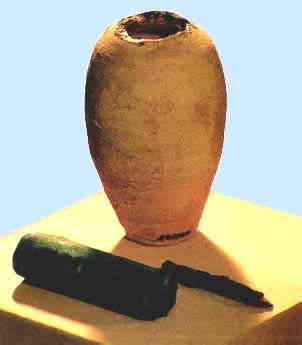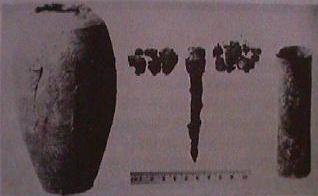|
 The Baghdad Batteries:
(Electric Cells)
The Baghdad Batteries:
(Electric Cells)
|
It was in 1938, while working in
Khujut Rabu, just outside Baghdad in modern day Iraq,
that German archaeologist Wilhelm Konig unearthed a
five-inch-long (13 cm) clay jar containing a copper
cylinder that encased an iron rod.
The vessel showed
signs of corrosion, and early tests revealed that an
acidic agent, such as vinegar or wine had been present.
(2)
They are commonly considered to have
been intentionally designed to produce an electric
charge.
"They are a one-off. As far as we
know, nobody else has found anything like these. They
are odd things; they are one of life's enigmas."
Quote: P. Craddock. Metallurgy Expert,
British Museum.
|
 |
Railway construction in Baghdad in 1936, uncovered a copper cylinder with
a rod of iron amongst other finds from the Parthian period. In 1938, these
were identified as primitive electric cells by Dr. Wilhelm Konig, then the
director of the Baghdad museum laboratory, who related the discovery to
other similar finds (Iraqi cylinders, rods and asphalt stoppers, all
corroded as if by some acid, and a few slender Iron and Bronze rods found
with them). He concluded that their purpose was for electroplating gold and
Silver jewellery.

Railway construction in Baghdad in 1936, uncovered a copper cylinder with a
rod of iron amongst other finds from the Parthian period. In 1938, these
were identified as primitive electric cells by Dr. Wilhelm Konig, then the
director of the Baghdad museum laboratory, who related the discovery to
other similar finds (Iraqi cylinders, rods and asphalt stoppers, all
corroded as if by some acid, and a few slender Iron and Bronze rods found
with them). He concluded that their purpose was for electroplating gold and
Silver jewellery.

The Object he first found (left), was a 6-inch high pot of bright yellow
clay containing a cylinder of sheet-copper 5 inches by 1.5 inches. The edge
of the copper cylinder was soldered with a lead-tin alloy comparable to
today's solder. The bottom of the cylinder was capped with a
crimped-in copper disc and sealed with bitumen or asphalt. Another
insulating layer of Asphalt sealed the top and also held in place an iron
rod suspended into the centre of the copper cylinder.
Two separate experiments with replicas of the cells have
produced a 0.5-Volt current for as long as 18 days from each battery, using
an electrolyte 5% solution of Vinegar, wine or copper-sulphate, sulphuric
acid and citric acid, all available at the time. (One replica produced
0.87-Volts).
BBC News Article :
February 2003
Most sources date the batteries to
around 200 BC - in the Parthian era, circa 250 BC to AD 225.
Skilled warriors, the Parthians were not noted for their
scientific achievements.
"Although this collection of objects
is usually dated as Parthian, the grounds for this are
unclear," says Dr St John Simpson, also from the department
of the ancient Near East at the British Museum.
"The pot itself is Sassanian. This
discrepancy presumably lies either in a misidentification of
the age of the ceramic vessel, or the site at which they
were found."
(2)
From the same Article, these prophetic
words of wisdom:
'War can destroy more than a
people, an army or a leader. Culture, tradition and
history also lie in the firing line. Iraq has a rich
national heritage. The Garden of Eden and the Tower of
Babel are said to have been sited in this ancient land.
In any war, there is a chance that priceless treasures
will be lost forever, articles such as the "ancient
battery" that resides defenceless in the museum of
Baghdad'.
Unfortunately, the Baghdad batteries are now
lost to us following the looting of the Baghdad museum in 2003.
This article appeared in the Guardian:
Thursday April 22 2004.
The situation in Iraq makes the fate
of the 8,000 or so artefacts still missing from the National Museum
of Baghdad ever more uncertain. Among them is an unassuming looking,
13cm long clay jar that represents one of archaeology's greatest
puzzles - the Baghdad battery. The enigmatic vessel was unearthed by
the German archaeologist Wilhelm Koenig in the late 1930s, either in
the National Museum or in a grave at Khujut Rabu, a Parthian site
near Baghdad (accounts differ). The corroded earthenware jar
contained a copper cylinder, which itself encased an iron rod, all
sealed with asphalt. Koenig recognised it as a battery and
identified several more specimens from fragments found in the
region.
He theorised that several batteries would have been
strung together, to increase their output, and used to electroplate
precious objects. Koenig's ideas were rejected by his peers and,
with the onset of the second world war, subsequently forgotten.
Following the war, fresh analysis revealed signs of
corrosion by an acidic substance, perhaps vinegar or wine. An
American engineer, Willard Gray, filled a replica jar with grape
juice and was able to produce 1.5-2 volts of power. Then, in the
late 1970s, a German team used a string of replica batteries
successfully to electroplate a thin layer of silver.
About a dozen such jars were held in Baghdad's
National Museum. Although their exact age is uncertain, they're
thought to date from the Sassanian period, approximately AD 225-640.
While it's now largely accepted that the jars are indeed batteries,
their purpose remains unknown. What were our ancestors doing with
(admittedly, tiny) electric charges, 1,000 years before the first
twitchings of our modern electrical age?
Certainly the batteries would have been
highly-valued objects: several were needed to provide even a small
amount of power. The electroplating theory remains a strong
contender, while a medical function has also been suggested - the
Ancient Greeks, for example are known to have used electric eels to
numb pain.
Of particular interest in relation to the Baghdad
Batteries is the suggestion that they was used in order to electroplate Copper
Vases with silver, which were also once to be found in the Baghdad museum.
They had been excavated from Sumerian sites in southern Iraq, dating 2,500
-2,000 BC.
(More about Prehistoric Iraq)
Paul
T. Keyser of the University of Alberta in Canada has come up with an
alternative suggestion. Writing in the prestigious archaeological
Journal of Near Eastern Studies, he claims that these batteries
were used as an analgesic. He points out that there is evidence that
electric eels were used to numb an area of pain, or to anaesthetize
it for medical treatment. The electric battery could have provided a
less messy and more readily available method of analgesic.
Of
course the 1.5 volts that would have been generated by such a device
would not do much to deaden a patch of skin, so the next conclusion
was that these ancient people must have discovered how to link up
several batteries in series to produce a higher voltage.
(1)
'The Chinese had developed acupuncture by this
time, and still use acupuncture combined with an electric current.
This may explain the presence of needle-like objects found with some
of the batteries'. (2)
(Early
Examples of Electricity)
(Anomalous
Artefacts)
(Sumeria)
(Ooparts)
|


